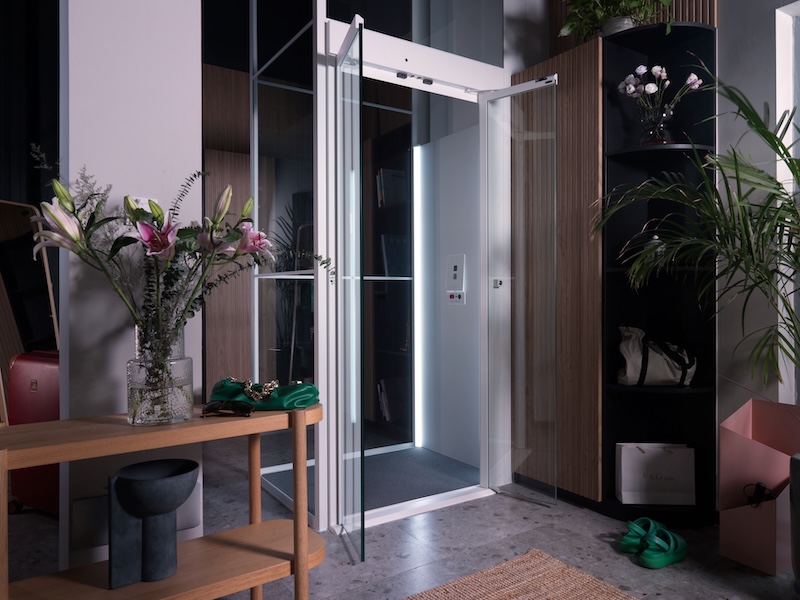
Domestic lifts are becoming increasingly popular across the UK. Nevertheless, understanding the domestic lift cost can be daunting. Prices vary widely, influenced by factors like the type of lift, installation complexity, and custom features.
In this guide, we’ll break down the costs associated with domestic lifts in the UK. We’ll cover the key factors that influence pricing, discuss cost considerations, and offer budgeting tips to help you make an informed decision.
Factors Affecting Domestic Lift Cost in the UK
There’s no one-size-fits-all answer to how much a domestic lift will cost. Prices depend on several factors, including lift type, installation complexity, and additional features.
Type of Lift
1. Hydraulic Lifts
This traditional lift has higher upfront costs but is known for smooth operation. They are suitable for homes requiring a robust and reliable lift system. These lifts are often powered by hydraulic fluid, which helps the lift move smoothly between floors. They are a good choice for multi-storey homes where reliability is a top priority.
2. Traction Lifts
This type of lift is more efficient, quieter, and more energy-saving and falls in the mid-price range. Traction lifts rely on a system of ropes and counterweights. This makes them more energy-efficient than hydraulic lifts. Their quiet operation makes them well-suited for residential use where noise may be a concern.
3. Pneumatic Lifts
Modern and compact. It is slightly pricier due to advanced technology, but it is ideal for limited space. Pneumatic lifts operate using air pressure, making them lightweight and easy to install. They are a good fit for homes with minimal structural modification options.
4. Platform Lifts
Budget-friendly, though typically more basic in design. Suitable for wheelchair accessibility. Platform lifts are designed primarily for vertical travel, and you can install them with minimal structural changes. They are practical if you prioritise accessibility without the need for elaborate design features.
Installation Complexity
1. New Build vs. Retrofit
Retrofitting an old lift into your home can increase the costs. This is because existing structures may need reinforcement or alteration to fit your lift system. This can also add both time and expense.
2. Space Requirements
Some lifts require a dedicated shaft, which can increase the overall price. In homes where space is limited, this may involve significant rearrangement or even extending the property, adding to the complexity.
3. Labour Costs
Costs vary based on the region and complexity of the installation process. Urban areas often have higher labour rates, and more complex projects requiring specialist skills can increase expenses.
Number of Floors & Travel Distance
Single vs. Multi-Storey Lifts
Lifts covering multiple floors are often more expensive than single-level lifts. The higher the lift travels, the more powerful and durable the system needs to be, which can impact both equipment and installation costs.
Pit & Headroom Requirements
Additional structural adjustments may be necessary, increasing costs. Some lift models require a pit for the base mechanism or extra headroom to house the motor, which can be challenging in homes with low ceilings or limited floor space.
Lift Features & Customisation
Standard vs. Bespoke Designs
Custom finishes, luxury materials, and smart controls add to the overall cost. Choosing bespoke designs allows you to match the lift’s aesthetic to your home’s interior, offering a personalised touch that enhances visual appeal.
Energy Efficiency & Sustainability
Though they might cost more initially, energy-efficient lifts save on long-term running costs. Opting for sustainable models can reduce energy consumption and lower utility bills, making them a cost-effective choice in the long run.
Pricing Breakdown – How Much Does a Domestic Lift Cost in the UK?
Rather than focusing on specific amounts, let’s discuss the variations based on the type of lift, installation complexity, and added features. Some lifts are more affordable due to their basic design than others that require a higher investment due to modern technology or customisation.
Additional Costs to Consider
When planning for a domestic lift, it’s essential to think about building modifications, permits, regular maintenance, and potential warranty packages. These factors can all influence the total investment.
Budgeting Tips: How to Choose the Right Lift for Your Home
Consider your needs and how the lift will fit into your home. Get multiple quotes to compare every domestic lift cost, and think about the long-term value, including maintenance and energy efficiency. You may also want to explore grant opportunities if mobility is a concern.
Conclusion
Choosing the right domestic lift involves considering various factors, from lift type to installation complexity. While costs can seem daunting, investing in the right lift adds convenience, safety, and value to your home.
At SWIFT Lifts, we understand the challenges of choosing and installing a domestic lift. Contact us today for expert guidance and a personalised quote to enhance your living experience.
Get in Touch!










